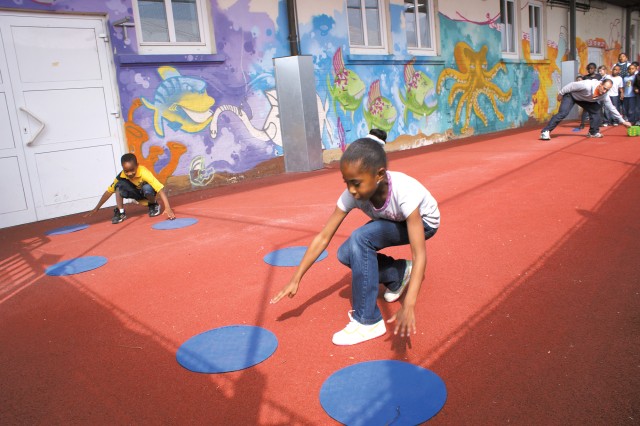
HEIDELBERG, Germany -- "You're a winner if you're having fun," said Thorsten Damm, program manager for the Ballschule Heidelberg during a session at School-Age Services on the Community Support Center May 13.
For 10-15 first and second graders, every Wednesday is Ballschule day, a time to be active and have fun. They are also learning skills that will help them at various sports throughout their lifetime.
The goal of Ballschule, a program developed by University of Heidelberg's Institute of Sport and Sport Science, is not to teach children how to be the next soccer superstar, but to introduce them to the basics of sports while keeping them active and having fun.
You won't find a coach ordering drills or a pick up game of any sort at Ballschule, instead the games are the type of invented games kids naturally play in their neighborhoods, but with the scientific research behind them to ensure they are effective.
One skill they try to teach is "finding the gap," according to Damm, which has application in most sports whether it's figuring out where to hit a line drive or what part of the goal to kick the soccer ball.
There are several other basic skills - like hitting the target, playing together as a team, and maintaining possession of the ball - that the Ballschule staff try to teach the children through a variety of games.
"So the child gets an idea of how the ball flies through the air," Damm said, adding that the children are at the golden age for learning.
"All their synapses are forming and if you reduce the instruction, they get bored and learn less compared to what they could do."
The staff, however, doesn't teach the children how to kick or throw the ball but allows them to learn through trial and error what works best while keeping the games fun and active.
"Everything is played at game speed," said Tim Mickens, lead child and youth program assistant at SAS. "We try to tire them out for the parents."
The Ballschule program was developed at the Institute in 1998, in response to the decline of German sports teams, Damm said.
Through research the institute learned that children in Germany weren't getting out and playing unlike in other countries like Brazil, where the children play a variety of games in the streets.
The idea was to allow the children to have free play in a safe environment. Today more than 1,000 elementary school children in from the Heidelberg area participate in the program along with more than 100 sports clubs offering the program.
Ballschule can also be found in several other German cities and in a few locations in Brazil and Japan.
The program has been offered at SAS since September and was brought to the American community by Damm to build the relationship between Germans and Americans.
Damm attended college in Alabama and knew of the American population in Heidelberg and decided to introduce Ballschule to the American children in the area.
"(The program) taps into expertise and offers our community something not usually available," said Dawn Grossman, SAS director.
And the children respond to the program. While lining up to head outside, several children came to Mickens and asked if they could play.
Because, despite all the science behind the program, the goal, according to Mickens, is to "try to make it fun."
(Editor's Note: Jason Austin writes for the USAG Baden-WAffA,A1/4rttemberg newspaper, the Herald Post.)"

Social Sharing